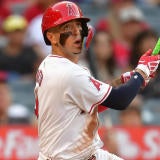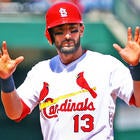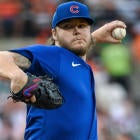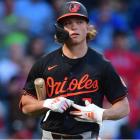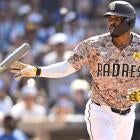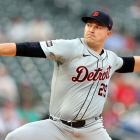Note: Don't whiff on this special FanDuel offer. Win your first contest or get your money back (up to $10) to keep playing. Try FanDuel now!
Every April, a few hitters emerge from the offseason and spring training looking nothing like their former selves, leaving us Fantasy owners to figure out what to expect going forward. Who knew that Jean Segura hit for this kind of power? Or that Odubel Herrera likes to draw walks?
Roughly two weeks of data in isolation can't tell us very much, but if it confirms a pattern from late last season, it can bring a player's changing skill set into better focus.
Eight hitters in particular produced second halves in 2015 that were confounding, but in the early going, some of them have been carrying over their newfound approaches. Others have turned in yet another direction, making it even more difficult to know what sorts of hitters they will be over the long haul.
Because each of these players took on a different look over the course of several months, they bear watching all season regardless of what they have done in the first two weeks. However, we'll start our analysis with the four players in this group whose changes have stuck so far because they are the ones who are making it easier to buy into what they started last season.
Note: Stats are for games played through Monday, April 18. Data are from FanGraphs, except where noted.
Staying the Course
Carpenter started off 2015 in typical fashion, spraying line drives to all fields, but by the second half, he was looking increasingly like an all-or-nothing type of hitter. His strikeout rate after the break was a robust 26.3 percent, and his pull rate jumped from 35.4 to 44.2 percent. The new approach had a clear payoff in terms of power production, as Carpenter slammed 19 home runs in the second half.
Though Carpenter has toned down the strikeouts, he is still ahead of his typical pre-2015 pace, and he is pulling the ball even more than he did late last season. With two home runs, four doubles and a triple after 13 games, it's safe to say that Carpenter is still enjoying fruits of an increased emphasis on power. As you can see from the Twitter poll results from less than two months ago, owners were heading into drafts unconvinced that Carpenter was a changed hitter, but the early returns suggest otherwise.
Which of these outcomes is likelier for Matt Carpenter this season?
— Al Melchior (@almelccbs) March 1, 2016
Now would be a good time to make an offer for Carpenter and his emerging home run clout before it becomes even more obvious that last season's changes have taken root.
You know what they say ... as players develop, triples turn into home runs. Well, that actually gets said about doubles, but the triples version worked for Fowler last season. As a 29-year-old, Fowler was at an age where players generally enjoy a plateau, but in the second half, he took his AB/HR and HR/FB ratios to a new level. In 71 games after the break, Fowler hit "just" four triples, but he mashed nine home runs to go along with 16 doubles. It's probably no coincidence that Fowler's pull rate climbed nearly six percentage points.
In this young season, Fowler continues to pull the ball at a rate far above the current major league average of 39.4 percent. He is off to a great start overall, and he hasn't lacked for power, hitting three home runs, four doubles and a triple through 13 games. These stats mean little unto themselves, but when folded into last season's second half stats (12 home runs, 20 doubles and five triples in 84 games), it gives credence to the idea of Fowler as a 20-homer threat.
Moustakas has also had a love affair with pulling the ball, and his is much longer-standing than Fowler or Carpenter. What's interesting about Moustakas' case is that he changed course twice last season. After years of a pull-heavy approach, Moustakas went the other way literally and figuratively for much of 2015. It wasn't until the final month of the season that he started pulling the ball in earnest again. Moustakas just happened to launch seven home runs from Sept. 6 forward.
He has picked up right where he left off and then some. While Moustakas ranks fifth in the majors in pull rate, he is also tied for eighth in home runs with four. He is batting just .217, and while his .167 BABIP will surely rise, there is little reason to think he will be even close to an average hitter on balls in play. Unless he changes course again.
Kinsler has become a more aggressive hitter in recent years, but he took that approach even further late last season, ranking 23rd in swing percentage in the second half. That took an enormous toll on Kinsler's walk rate (3.4 percent), but it helped to pare his strikeout rate to 9.6 percent. The net effect was a .347 on-base percentage that was eight points higher than his first half mark. While Kinsler continued to get on base at a reasonable clip, his power blossomed. He posted a .170 Isolated Power after the break that would have been higher if not for the final month in which his pull and hard contact rates plummeted.
Why would a more aggressive approach lead to more power? And what was behind the late-season power outage? There are no obvious answers, but given that a swing-happy approach and enhanced power have coupled themselves again in the early going, it just may be that Kinsler's four homers in 11 games is the beginning of something bigger -- and unexpected.
Now here are four more players who ended 2015 in a curious way. However, their early 2016 numbers have only muddied their outlooks.
Still Need More Data!
Paul Goldschmidt, 1B, Diamondbacks: The Arizona slugger has never been much of a pull hitter, but he took his aversion to hitting to left field to extremes in 2015, especially in the second half. After posting a 28.7 percent pull rate after the break, Goldschmidt has come out of the gate with a 45.5 percent rate that would be a career high. Will he sacrifice a .300 average for a chance at some extra home runs?
Jason Heyward, OF, Cubs: In his lone season with the Cardinals, Heyward didn't experience the power rebound that owners had hoped for, and a career-high 57.2 percent ground ball rate didn't help. That rate hit its peak in September, when two-thirds of his hit balls were grounders. He has reversed course so far this season with a 44.4 percent rate. It hasn't translated into extra-base power, though, as Heyward's average flyball distance of 238.9 feet is the eighth-lowest among qualifiers (per BaseballHeatMaps.com).
Kole Calhoun, OF, Angels: Those 19 home runs that Calhoun hit from July forward were fueled by a sharp increase in pull rate. He was a steady power source, hitting at least six home runs in each month and also posting a pull rate of at least 46 percent in each month. So, of course, Calhoun has pulled a whopping 33 percent of his hit balls so far, and he has one home run and three doubles in 52 plate appearances to show for his troubles. At least his aversion to pulling has helped him to bat .354, including .556 against the shift.
Asdrubal Cabrera, SS, Mets: Cabrera had a nice second-half power surge, clubbing 1o home runs in 57 games after the break. Since he cut back on strikeouts and hit flies for greater distances, it stood to reason that there could be more homers where those came from. Cabrera's K-rate is up a couple of ticks to 17.4 percent, and his flyballs have averaged just 267.9 feet. That may explain why Cabrera has yet to go yard after 46 plate appearances. Or maybe he just needs more plate appearances.










